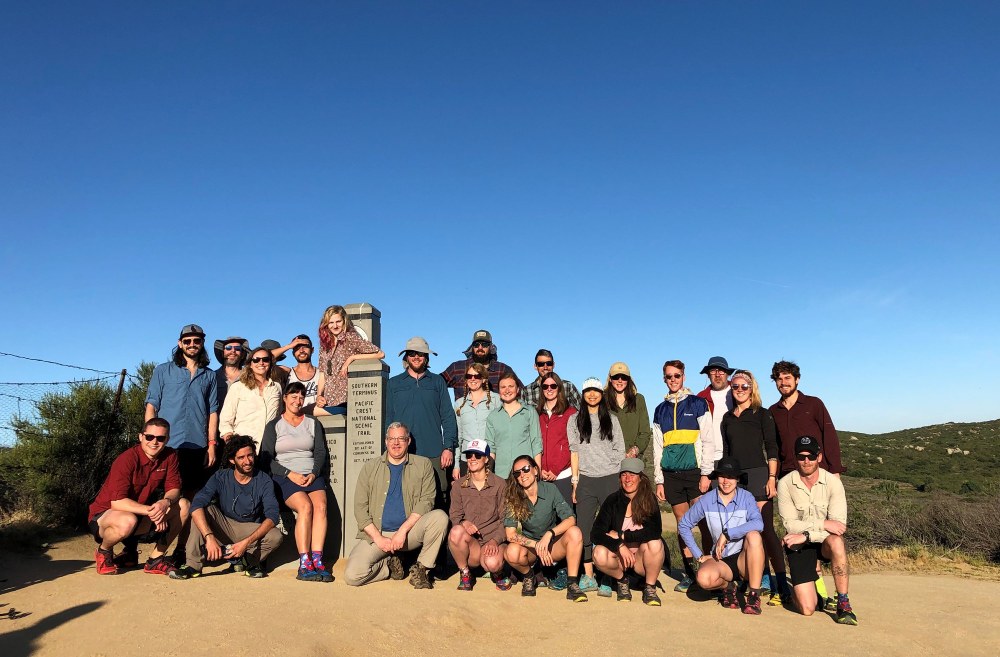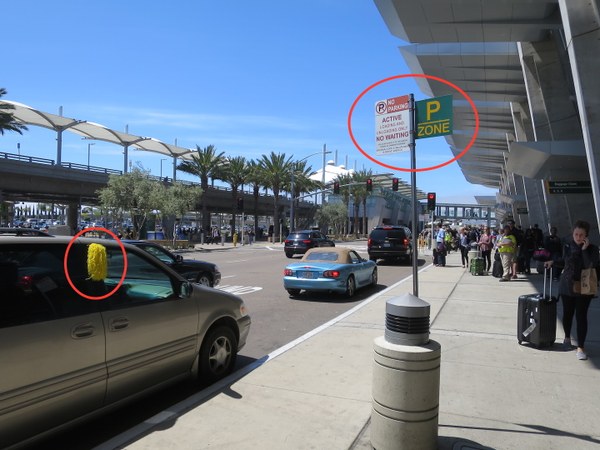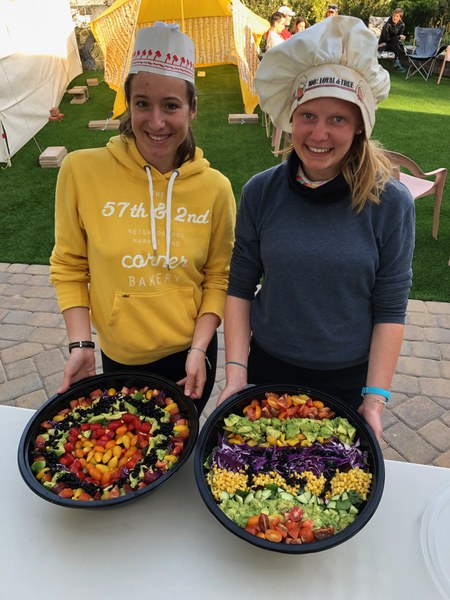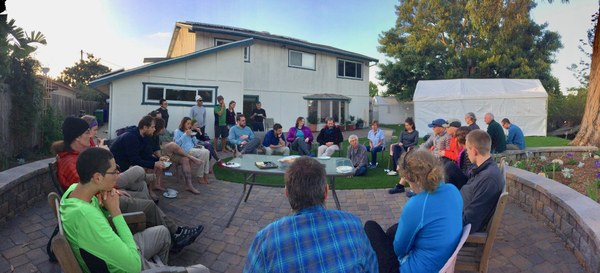
You quit your job, sublet your apartment, and sold your car. Standing on the curb at the San Diego airport, everything you know has been left behind. There’s just you and your backpack, and a dream so big you wonder again: Will it fit that five-month hole I’ve carved out of my life? You’re looking for a yellow pompom. Just like more than 6,000 others before you.
You’ve come to thru-hike the Pacific Crest Trail. Strangers you’ve never met — Scout and Frodo — said they’d put you up for a night, feed you, and drive you out at sunrise to the trailhead.
Do people notice I’m different? This is the only shirt I’ll wear for five months. You ache from five hours on the plane. Your ears echo with the voices of family and friends. “You’re crazy.” “I wish it were me.” “I’d never do that.” And you shut out those three questions you’ve repeatedly heard: “Why are you doing this?” “Are you carrying a gun?” “You’re not going alone, are you?”
Then a hand taps your shoulder. It’s a woman in hiking togs clutching her own pack. “Thru-hiker?” she asks. Then you both notice a tan van driving up. There’s the yellow pompom.
The van pulls to the curb, hikers grinning at you from inside. The woman driver opens the back gate and extends her hand. “I’m Frodo.” This is real. You’ve held your breath for months and now you can finally exhale. I’ve come home. I’ve found my people. I’m actually starting my hike.
 Hikers are picked up at the "P" zone at the San Diego airport by a vehicle sporting a yellow pom pom. All photos courtesy of Barney Scout Mann.
Hikers are picked up at the "P" zone at the San Diego airport by a vehicle sporting a yellow pom pom. All photos courtesy of Barney Scout Mann.
PCT hopefuls
Each spring a PCT hiker migration arrives in San Diego as faithfully as Puget Sound’s gray whales. The PCT southern monument — five legendary fir pillars perched on a desert rise sixty miles inland — is their immediate goal. But getting there can be a nightmare. Without a local friend or relative, it takes three trips on public transportation totaling at least a half day. When you step off the bus over a mile from the PCT trailhead, there’s not even a sign telling you where the PCT begins. If you camp nearby, you invite a gruff midnight wake-up by Border Patrol. Some hikers have called “Day Zero” the worst day of their hike.
In 2006, my wife Sandy and I were PCT dreamers, planning a thru-hike attempt for the following year. We live in San Diego in a suburban home on a quiet cul de sac. Sandy was a high school biology teacher; a 5’2” empress of her classroom who stayed up late baking pumpkin muffins for her students. I was managing partner of a small law firm; my lanky frame felt chained to a desk. We were going to trade it away for six months off to hike the PCT. For 10 years we’d clutched our PCT dream tightly. We planned to celebrate our 30th wedding anniversary on our thru-hike. After all, Sandy and I never had a first date — we had a first backpack.
Not long before our own hike, our youngest left for college. Was it those four empty bedrooms? Was it our urge to meet PCT hikers? Either way, our desire to connect with the PCT overruled the conventional wisdom of “don’t invite strangers into your house,” and that spring we hosted 17 hikers. We thought we were pretty hot stuff.
In 2007, we hosted 35 hikers before setting out on our own Mexico-to-Canada trek. That thru-hike gave us trail names, innumerable blisters, one broken rib, and two cracked front teeth. Sandy became “Frodo” and I became “Scout.” Between us we wore out eight pairs of jogging shoes. In October, 50 miles from Canada, we plunged forward through knee-deep snow. Nothing would stop us.
The next spring, in 2008, we hosted 125 PCT hikers, over a third of that year’s thru-hiker class. By 2011, we topped 200. Then the book and subsequent movie Wild burst on the scene, and PCT hiker numbers skyrocketed.
A few extra mouths to feed
What began as home-cooked meals for a few extra mouths soon exceeded the dining table’s capacity, even with all three leaves in place. One night 65 slept in our home — our bedrooms, tent trailer, living room floor, and tree house were stuffed to the gills. The tents in our backyard were pitched as close as sardines in a can.
We tried to set sanity limits for ourselves. A one-night stay for those from the U.S. and three nights for international hikers. We set a limit of 40-ish people a night — and felt bad. We made exceptions as often as we enforced the rule.
In 2008, we had our first ad hoc volunteer. “Scout and Frodo, can I help?” That one morphed into a legion of good Samaritans. In 2019, I wrote 81 thank-you letters to volunteers. Twenty-two of them were live-in volunteers. Nowadays, during our eight-week season, at least three are here at a time.
Five years ago, one volunteer began a standardized hosting chore list. It’s now up to fourteen separate categories and 46 items. They include clean and set up coffee makers, alphabetize incoming hiker boxes, change treehouse mattress sheets, run pack shakedowns, shuttle hikers to the trailhead, to gear, grocery, or AT&T stores, and pick up hikers at the airport, Amtrak, Greyhound, or hostels.
Every morning without fail, four to 10 vehicles drive hikers to the trail. Usually only one is ours. The rest are from a team of more than 50 volunteer drivers. They arrive at 5:30am, join the hikers for breakfast, and the last taillights disappear from the cul de sac by 6am. It’s 120 miles round trip. Many volunteers drive five, 10, or even 15 times in a season.
Every day, we make six to 10 airport pickups, grouping hikers who arrive within an hour of each other. A hiker might see our tan van, our green or silver Prius, or any of the score of vehicles driven by our volunteers. How do hikers know what vehicle to expect? We don’t decide who’s driving until the night before. The solution was as close as our back closet. We’re former University of Oregon Ducks, and there in the closet we had a half dozen bright-yellow pompoms.
 Two of the many hikers who volunteer to help with meal preparation.
Two of the many hikers who volunteer to help with meal preparation.
Systems within systems
But how does all this run? And what about the cost? In 2006 we were clear: no gifts, no donations. Fourteen years later, it’s still all free to hikers. Our website homepage says: “We provide our services at no charge and we do not accept donations.” We make Costco runs twice a week, $500 or more a pop, and our utilities bill is crazy, but we simply don’t think about it. Every night when we flop into bed, alarms set for 4:30am, we turn to each other and say, “We are so lucky to be able to do this.”
As for organizing it all, one hiker wrote; “They have systems within systems. It’s like a freak’n cuckoo clock factory.” He wasn’t that far off. To get the time we want to spend with hikers, the back end of the operation has to run like a fine clock. We have mastered google doc spreadsheets. Hikers sign up online, their information instantly populating one spreadsheet, then that spreadsheet feeds a separate online volunteer sign-up sheet. At any hour a volunteer driver can see how many hikers are going out on a given morning and how many seatbelts we still need. When they sign up, they get the satisfaction of seeing that seatbelt number immediately go down.
For Costco, Frodo had a stroke of genius. For years we made a new list every time: 10 pineapples, 12-dozen eggs, etc. Then she made a standardized list of all the things we might buy and all we had to do was fill in the quantity. However, the genius part was when she put the list in the order in which you walk through the store. Armed with that, I can get in and out in under an hour. Half the time the checker will ask, “Where’s the party? Can I come?”
Priceless connections
Since 2008, over a third of each year’s PCT thru-hiker class stay with us. Word of mouth, hiking blogs, guidebooks, and even the Pacific Crest Trail Association’s official website report, “Stay at Scout and Frodo’s.” We’d get emails that began, “Never in my life have I asked a total stranger to pick me up and give me a place to stay. But they tell me it’s okay.”
The moments we get to share are priceless. One night the dinner conversation was being dominated by boisterous French, German, and Italian hikers. A quiet young man from Portland, Oregon, silently chewed his food. In a lull someone turned to him and asked a question. His answer cut us to the quick. “Two days ago I got out of the Army.” He’d served in Iraq. “My days consisted of 12 hours standing erect as a Humvee turret gunner.” One night back at base, he chanced upon a PCT trail journal. He was hooked, mesmerized in his plywood-wall quarters. He read about all of us. That’s when he decided to thru-hike the PCT. As he finished his story and just before he picked up his fork again, he looked at us all on the eve of his own PCT hike and said, “Why am I thru-hiking? When I look back on my youth, I don’t want the seminal event to be Iraq.”
Every day at our house offers a graduate class on people. Even something as small as our “hiker box” has taught me an important lesson. Every PCT re-supply town has a hiker box. It’s a bin or box where hikers leave cast-off gear that still has a useful life, leave their excess backpacking food and supplies, all for other hikers to pick through and take. It may be at a small hotel, post office, or store. At our house we have “Hiker Box Zero.”
With our numbers now over 1,000 a season, the volume of stuff left in our hiker box is huge. I guess I don’t really need a 2-pound mallet for tent stakes. Every day we cull the totally inappropriate, weird things people thought they couldn’t hike without. The worst make great stories. I once found a marine emergency flare, with the pull-string hanging loose, capable of shooting a rocket 1500 feet into the sky — or knocking a hole in our ceiling. For a year one of my favorites was a four-pound, six-inch-thick stack of trail maps, each page individually laminated. Someone had carried it here and then left it in the hiker box secured by a rubber band. All that season it sat alongside our hiker box for laughs.
The next year we had a new live-in volunteer, a young woman from Australia. She heard me tell the tale and when the last laugh subsided, she pulled me aside. “Scout,” she said, “Those were mine. I brought them last year. My dad didn’t get my hike at all. He was afraid for me and wouldn’t talk about it. Still, he saw me off at the airport. Just before boarding he gave me those maps. He’d spent weeks printing and laminating them by hand.”
All that time, I’d thought those maps were ridiculous. I’d had no idea what they really represented: a father’s love for his daughter.
 The evening backyard "dinner talk" led by Scout and Frodo.
The evening backyard "dinner talk" led by Scout and Frodo.
The unseen magic of trail angels
Our hosting has an impact far beyond us and our hikers. Our local post office was short-listed to close until thousands of priority mail re-supply boxes started issuing from our house. Today the American flag still proudly flies over the University City Post Office. We pack the local AT&T store many days with international hikers needing U.S. phone plans, numbering over 400 last year. Sometimes the manager drives to our house and opens up AT&T in the living room.
Early on we realized we have a tremendous opportunity to affect hiker behavior for the good. We do an after-dinner talk every night, more than 60 times a season. Between jokes and stories about the guy whose trail name is Cuddles, we talk about being a good trail ambassador, Leave No Trace, and stream crossing safety.
My saddest moment as a trail angel was in 2017, three months after our hosting season ended. I was in my tent at midnight, thru-hiking the Appalachian Trail. I had cell coverage and I reached Frodo back at home. It had been a high snow year on the PCT. Frodo told me about Tree and Strawberry, two strong, slender young women, both competent hikers. One was from mainland China and the other from Japan. They’d each stayed with us for three days and we got to know them well. Frodo’s voice caught and choked up. “They found Tree and Strawberry’s bodies this week.” They were at two different Sierra stream crossings. Each had tried to cross high water alone.
In our dinner talk I mention their names every night. I describe a series of crossing strategies, including, “If you’re alone at a hard stream crossing, stop and wait. Someone else will come along.”
Last summer, good friends told me they’d come on a lone hiker at a dangerous Sierra stream crossing. He told them he’d been waiting for three hours. “Why?” they asked. “These folks, Scout and Frodo, that’s what they told me to do. Frodo said I should make wise decisions.” The three of them crossed safely together.
Many people ask, why do Sandy and I host hikers? We host to help people at a vulnerable time in their life. We want to pay back the incredible kindness we received on our 2007 thru-hike. We get to meet the most amazing people from around the world. We positively affect hiker behavior up the trail. We send an incredible wave of kindness into the world. But most of all — we do it because we can.
 The author and his wife, Sandy "Frodo" Mann, on their 2007 PCT thru-hike.
The author and his wife, Sandy "Frodo" Mann, on their 2007 PCT thru-hike.
Join Barney for a Live Presentation
Want to hear more from Barney? Join us October 15, 2020 for a zoom presentation sharing excerpts from his new book, Journeys North, and stories from his PCT hike.
Barney Scout Mann is a thru-hiker and the author of Journeys North: The Pacific Crest Trail, published by Mountaineers Books. Hitting shelves this year, Journeys North tells the story of 6 PCT hikers – including Barney and his wife Sandy – as they face a once-in-a-generation drought and severe winter storms that test their will in this gripping adventure. Journeys North is a story of grit, compassion, and the relationships people forge when they strive toward a common goal.
This article originally appeared in our Fall 2020 issue of Mountaineer Magazine. To view the original article in magazine form and read more stories from our publication, visit our magazine archive.
 Barney Scout Mann
Barney Scout Mann